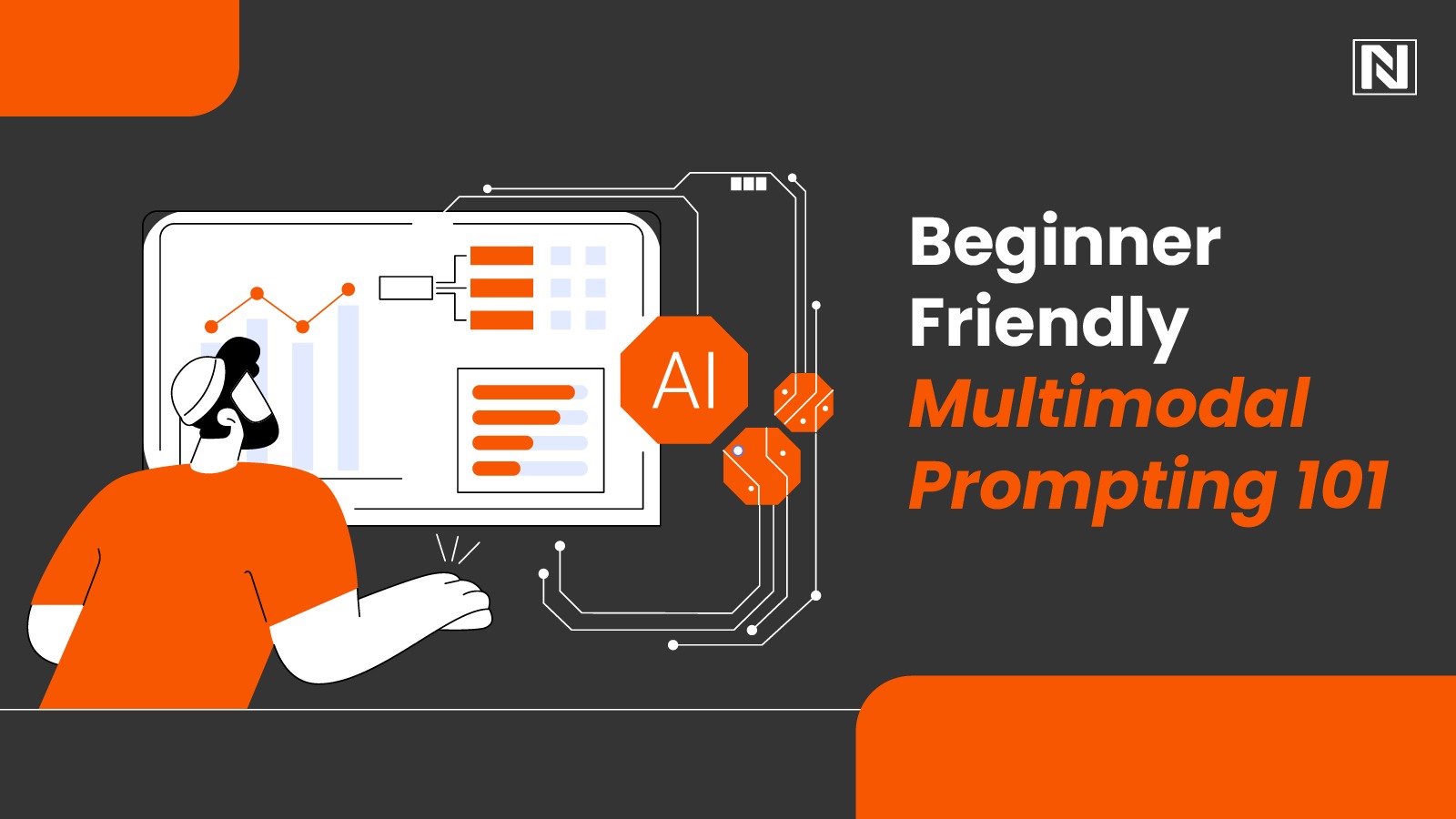
Artificial intelligence isn’t just about text anymore. Models today can process images, audio, video, and text in a single workflow, opening doors to richer applications that go beyond simple Q&A. This shift is powered by multimodal prompting, a method where different types of inputs work together to generate better, more context-aware outputs.
If you’ve only worked with text-based prompting so far, stepping into multimodal AI might feel like a big leap. But here’s the thing: the fundamentals aren’t that different, you’re just learning to speak the model’s language across more than one mode.
Let’s break it down.
What is Multimodal Prompting?
Traditional large language models (LLMs) like GPT were trained to understand and generate text. Multimodal models extend this by taking in multiple input types like combining an image with a question, or pairing audio with text to create responses that align with richer context.
For example:
- You can give an image of a system architecture diagram and ask the model to explain potential bottlenecks.
- You can provide an audio clip and a transcript, then ask the model to check for transcription errors.
- You can feed product photos along with marketing copy and request improvements tailored to visual features.
This is where prompt engineering for multimodal models comes in. It’s not just about writing clever text prompts anymore, it’s about designing structured, multi-signal inputs that guide the model effectively.
DID YOU KNOW?
The global multimodal AI market, valued at USD 1.0 billion in 2023, is expected to grow at a CAGR of 35.0% to reach USD 4.5 billion by 2028.
Why Multimodal Matters for Developers and Decision-Makers
Here’s why this isn’t just a research experiment and why leaders should pay attention:
1. Closer to Human Context
Humans naturally process multiple forms of data at once. We read text, view images, listen to audio, and merge those inputs to make decisions. Multimodal AI replicates that flow, which makes applications more intuitive.
2. Practical Edge in Real-World Use Cases
- A customer support system that can understand screenshots instead of relying only on user descriptions.
- A compliance tool that scans both financial reports and their accompanying graphs for anomalies.
- A medical AI that looks at lab results and radiology scans together.
These aren’t futuristic. They’re being built today.
3. Shift From Toy Demos to Deployable Systems
Multimodal prompting basics provide the framework for scaling AI beyond chatbots into production-grade systems that understand context across formats.
The Basics: How Multimodal Prompting Works
Think of it in layers:

- Inputs: Text, image, audio, video, or combinations of these.
- Encoding: Each input type is translated into embeddings, numerical representations the model can understand. For instance, an image gets mapped into feature vectors, just like a sentence does.
- Fusion: The model brings these embeddings together into a shared representation. This is where the “multi” in multimodal really happens.
- Decoding: The model generates an output (text, an image, or even structured data) based on the fused representation.
When you’re designing prompts, your job is to structure these inputs clearly so the model knows what matters most.
Prompt Engineering for Multimodal Models
Text-only prompt engineering has already taught us lessons: clarity matters, order matters, context matters. With multimodal, these lessons expand.
1. Explicit Role Assignments
If you give both an image and a text description, tell the model what role each plays. Example: “Analyze the attached diagram and compare it with the following text requirements.”
2. Stepwise Instructions
Break down tasks across modes. Instead of asking, “Is this product good?”, ask:
- Identify the product features in the image.
- Cross-check with the product description text.
- Suggest missing details in the description.
3. Guard Against Ambiguity
Models don’t “know” which modality is more important unless you specify. If the image is authoritative and the text is supplementary, state that upfront.
This is where a beginner guide to AI prompting for multimodal systems becomes crucial: the better you design your inputs, the less guesswork the model does.
Common Pitfalls Beginners Face
Even skilled developers hit snags with multimodal prompting. Some examples:
1. Overloading Inputs
Dumping multiple images and large chunks of text without clear structure confuses the model. Think “signal-to-noise ratio.”
2. Misaligned Context
If the audio clip talks about one subject but your text prompt references another, the model may fail to align them.
3. Forgetting Evaluation
Just because the model accepts multiple inputs doesn’t mean it uses them well. Build checkpoints: Did the output reference the image? Did it reflect the audio content?
Tools and Frameworks to Experiment With
If you’re hands-on, here’s where to start:

- OpenAI GPT-4o / GPT-4 Turbo with Vision
Handles text + image prompts. Useful for practical deployments like document analysis or UI testing.
- Google Gemini
Trained natively as a multimodal model. Can mix text, image, and audio inputs in a single workflow.
- Meta’s ImageBind
Focused on aligning six modalities (text, image, audio, depth, thermal, IMU). A great sandbox for exploring multimodal embedding space.
- Framework Layer
Tools like LangChain or LlamaIndex already support multimodal prompting integrations, letting you chain reasoning steps across modalities.
Designing for Production: Beyond the Basics
As a decision-maker, don’t just think in terms of technical feasibility. Think deployment.
1. Latency and Cost
Multimodal models are heavier. Evaluate whether processing an image per request is sustainable in real-world use cases.
2. Data Privacy
Images and audio often carry sensitive data. Build guardrails around compliance and storage.
3. Evaluation Metrics
Accuracy isn’t always obvious. For text, BLEU scores or human evaluation work. For multimodal, you’ll need cross-modal benchmarks and domain-specific KPIs.
What this really means is: multimodal prompting isn’t just a feature, it’s a system design decision that impacts infrastructure, costs, and compliance.
The Road Ahead
Here’s the reality: multimodal AI is going to be table stakes in the next few years. Just as text-only chatbots feel limited today, single-mode applications will soon look outdated.
Getting comfortable with multimodal prompting basics now gives your team the foundation to build tools that feel natural, context-aware, and future-proof.
For developers, it’s a playground to experiment with richer inputs. For leaders, it’s a strategy to expand AI’s impact across the business.
Closing Thoughts
Multimodal prompting isn’t about replacing text prompts, it’s about extending them. By combining text, images, audio, and more, you give AI the same variety of context that humans rely on every day.
If you’re new, start small. Pair text and images. Design structured prompts. Evaluate carefully. Once you’ve mastered those, scale to more complex workflows.
The beginner guide to AI prompting you’ve just read isn’t the end. It’s the opening chapter. Because as these models evolve, the real challenge won’t be whether they can handle multimodal inputs, it’ll be how well you and your team can design for them.
Frequently Asked Questions
What is multimodal prompting?
Multimodal prompting involves using multiple input types (text, images, audio, etc.) together to guide AI models for richer, context-aware responses.
Why is multimodal AI important?
It mimics human-like understanding by processing multiple data types at once, making AI applications more intuitive and practical for real-world use cases.
What are common pitfalls in multimodal prompting?
Overloading inputs, misaligned context (e.g., mismatched text and images), and failing to evaluate if outputs properly reference all input types.
Which tools support multimodal prompting?
OpenAI’s GPT-4o, Google Gemini, Meta’s ImageBind, and frameworks like LangChain or LlamaIndex for chaining multimodal workflows.
How does prompt engineering differ for multimodal models?
It requires structuring inputs clearly (e.g., assigning roles to each modality) and stepwise instructions to guide the model across text, images, or audio.
